This paper was originally submitted to the post print publication of Fotoconservación2011, Logroño, Spain, June 2011
1. Impact and response to authenticity scandals
Coming in close succession, major authenticity scandals in 1997 and 1999 involving photographs attributed to Man Ray and Lewis Hine sent a shudder of uncertainty across the collecting community. The realization that those at the top of the marketplace, including museums,private collectors, dealers, and auction houses,were vulnerable to fraud brought a heightened awareness that the value of a photograph, in all respects, is based on a subtle and complex material history.
As an objective understanding of photographic prints became a pressing concern, the conservator’s materials‐based knowledge grew in relevance. Not by accident, the Hine scandal ‐ the largest of its kind in the history of the fine art photography market ‐ was revealed through the work of art conservators. Exposing the fraudulent Hine prints hinged on the discovery of three constituents that should not have been present in photographic papers made prior to 1950. Identification of these anachronisms broke new ground for authentication methodologies and simultaneously illuminated significant gaps in the understanding of 20th century photographic papers. Seemingly simple questions, involving the chronology of manufacturer markings, use of certain fluorescent dyes, and various paper making fibers, took months to establish and even then remained open to question and challenge provoking years of additional, ongoing, research.
With sudden clarity, the assembly of reference collections of photographic paper became an urgent need. Responding to a growing imperative to establish the material history of the medium, individual conservators and collectors began amassing manufacturer sample books and packages of unprocessed paper. These collections were also a response to a growing realization that silver‐based, chemical photography was nearing its end as a commercially viable medium and that the materials of the 20th century photographer were rapidly disappearing and required preservation. Formed as a direct response to the art‐market frauds of the 1990s, the Messier Reference Collection of Photographic Paper presently contains thousands of papers identified by date, brand and manufacturer.

Concurrent with the development of reference collections, innovative methods to characterize the physical and chemical composition of photographic papers were initiated by conservators and scientists. New characterization techniques were needed not only to assist in determining the fabrication date of a particular print but also to provide insight into more subtle issues informing a photographer’s choice of paper by manufacturer, brand, surface finish, and other materials‐based characteristics.
As new characterization methods prove viable, the emphasis in the field is shifting toward more fully‐realized, practical applications. For example, a project designed to demonstrate the impact and significance of newly developed characterization techniques was undertaken to research lifetime and posthumous prints of Lewis Hine’s Powerhouse Mechanic. A range of novel approaches were deployed to help determine the origins and stylistic evolution of prints made of this iconic image.
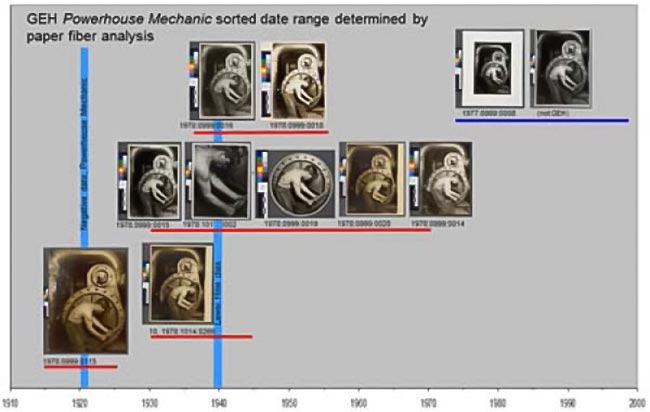
The field of photograph conservation would have been propelled toward undertaking a characterization agenda even without the catalyst of authenticity scandals. The rising market values of fine art prints combined with increasingly refined art historical scholarship made an understanding of the materials of the photographer an increasing priority. With more than a decade of retrospect it is also clear that the Lewis Hine controversy, in particular, provided a sense of urgency. With much at stake, the fine art photography market was quick to embrace the tools generated by the Hine research, spurring an ever‐increasing number of privately commissioned authentication studies. While these projects advance the field by challenging the conservators involved and supporting additional research through the acquisition of reference material, the necessity to guarantee confidentiality for private work inhibits a broader understanding among institutional and private collectors. Gradually, however, institutions have begun the process of incorporating many of these emergent techniques into their ongoing research agendas. For the Museum of Modern Art (MoMA), this integration has already resulted in a more definitive and nuanced understanding of the origin of key prints in its collection. At MoMA this work continues through a project backed by the Andrew W. Mellon Foundation to characterize the modernist prints of its Thomas Walther collection and to publish the methodologies and findings.
2. History of the 20th century black and white print
High profile fakes provoke some fundamental questions, even among those with long experience and expertise: Exactly what is a black and white print? For a particular print, how was it made and when was it made? How do we know for certain? In part, the answers lie in an understanding of the history of the medium.
Ubiquitous and ordinary, the “black and white” photograph represents one of the most significant, widespread and accessible imaging technologies in history. This success is owed to the rare combination of attributes possessed by silver gelatin developing out papers. Well processed and properly stored, a silver gelatin print has outstanding permanence especially as compared to almost any other photographic printing process. Silver gelatin papers have reliable handling properties in the darkroom, allowing quick and large‐scale production by amateurs and professionals alike. Capable of subtle manipulations and available in great variety, silver gelatin paper is a versatile medium for artistic expression, bearing countless masterworks of modern and contemporary art.
The origins of “black and white” papers are found in the late 19th century where silver bromide and silver chloride gelatin emulsions were applied to baryta‐coated papers for the first time. These papers were poorly received in part due to a lack of experience handling the new, highly light sensitive, papers. So called “gas light” papers addressed these handling problems by reducing light sensitivity thereby allowing photographers to make contact prints under low light conditions in a manner familiar to those accustomed to the preceding generations of printing out papers.

Though hugely successful in the amateur market, the advent of electric light enlargers in the late 1910’s and 1920’s and the increasing popularity of smaller format cameras gradually helped to supplant gaslight papers and provided new opportunities for paper manufacturers. A new generation of “enlarging” or “projection” papers resulted, forever moving photographic printing into the darkroom.
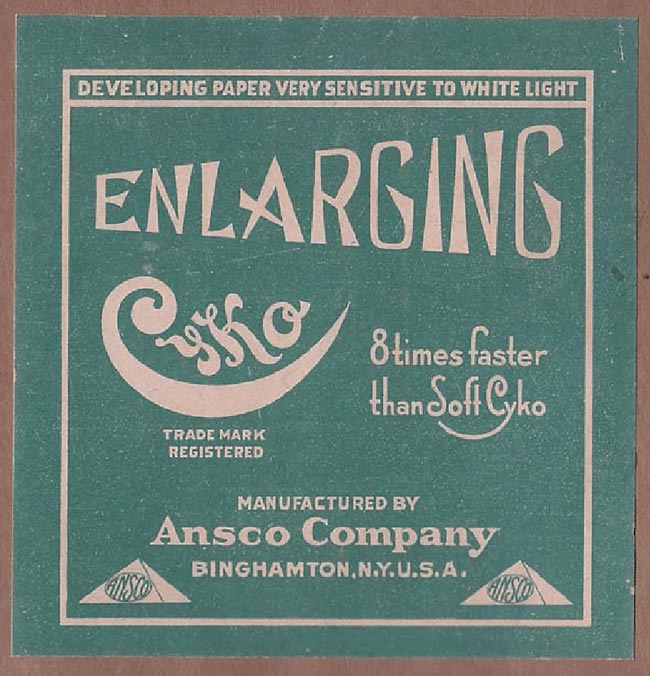
By the early 1930’s the dominance of silver gelatin developing out papers as a photographic printing medium was firmly established and assured. Competition among numerous manufacturers promoted a tremendous diversity as papers were produced with almost no limit to the combinations of paper color, weight, texture and sheen. In the 1940’s, these aesthetic and stylistic achievements were overshadowed by wartime shortages and new requirements for prints made quickly and cheaply. Following the war, manufacturers and photographers alike focused increasing levels of attention to color print materials.
While a large variety of black and white papers remained available, manufacturers gradually provided fewer and fewer choices. Consolidation among manufacturers also served to limit options for the black and white photographer. By the late 1960’s, black and white photography showed some remaining vitality as an art‐making medium even while color printing firmly and forever changed the work habits of photographers. During this period the market for black and white papers continued to decline, with fewer and fewer manufacturers, brands and surfaces. By 2005 when Eastman Kodak announced its inevitable but profound decision to stop production of silver gelatin papers, the impact was almost lost within the larger context of the shift from silver halide‐based photography to digital imaging.
With darkrooms shutting down, photographers, curators, collectors and conservators are being challenged to mark the historic transition away from chemical photography and interpret the gains and losses. Part of this accounting is the growing realization that any understanding of a photographic print must include a comprehension of the historical development, expressive potential and stylistic qualities of photographic paper.
3. Collecting, cataloguing and studying the papers of the 20th century photographer
A fundamental understanding of the history of photography is incomplete without access to primary source materials including technical literature and equipment. Access to well‐catalogued reference collections remains a pressing need to insure print research within the medium of photography can be based on a solid baseline of material fact. The largest collection of its kind in the world, the Messier Reference Collection of Photographic Papers was established to insure present day and future researchers would be guaranteed access to the materials of the 20th century photographer.
Papers typically enter this collection in manufacturer sample books or original manufacturer packages. The collection contains over 5,000 paper samples from more than 90 manufacturers and 475 brands. Samples are catalogued by manufacturer, brand, surface texture and reflectance. The samples fall into two broad categories: books of specimen prints and packages of unexposed photographic paper.
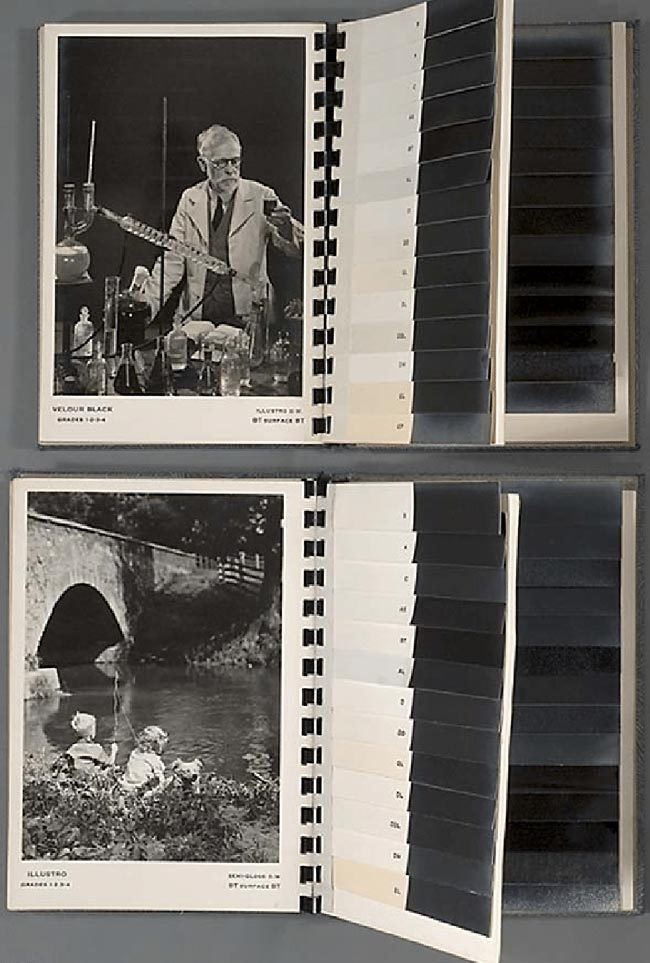
The collection is particularly strong between 1935 and 1965 with over 3035 samples included. Earlier material is much scarcer and is consequentially the highest collection priority. At present the collection contains a limited amount of material pre‐dating 1935 (roughly 480 samples). Paper marketed and sold in the United States is most heavily represented. There is moderate Western European representation, some papers from Eastern Europe and almost nothing from Russia, East Asia and elsewhere. The collection is supplemented by a reference library documenting materials and techniques as well as more than 520 instruction sheets for processing papers.
Conservators and art historians working with other media have long benefited from the study of reference collections of pigments, resins, gums, papers and textile fibers. In large part, the contemporary field of art conservation, from the standpoint of training, treatment, and scientific research, is based on the methodical study and characterization of these reference collections. The apparent lack of such resources in the field of photograph conservation, coupled with the rapid obsolescence of chemical photography, heightened the perceived need to collect as much as possible as quickly as possible. Considering the demise of silver‐based printing, the collection also serves an intrinsically valuable preservation function, providing a tangible connection to the methods and materials of 20th century photography.
4. Major studies
The collection of photographic papers has provided the basis for research and numerous collaborations. This work has significantly expanded the understanding of 20th century photographic prints. The initial focus of the work has been dating prints of unknown or questioned origin through the characterization of multiple criteria, including paper fiber and surface texture. Other research has concentrated on preservation issues including conservation treatment and display. The overall impact of the past and ongoing studies, outlined below, is a more nuanced appreciation of the diversity and complexity of silver gelatin papers. The studies in this section are grouped by category, summarizing research methods and findings as well as acknowledging partners and collaborators.
4.1 Optical brighteners and fluorescence
The reference collection was surveyed for the presence of optical brightening agents. Only fiber‐based, silver gelatin papers were assessed. In all 1,659 samples were examined, dating from 1896 to 2004 and representing 40 different manufacturers. No optical brightening agents were found in samples dating from 1896 to 1954. The first occurrence of optical brightening agent was found in samples dating from 1955. Starting from this point, the frequency of occurrence for optical brightening agents increased rapidly between the years 1955 and 1970.
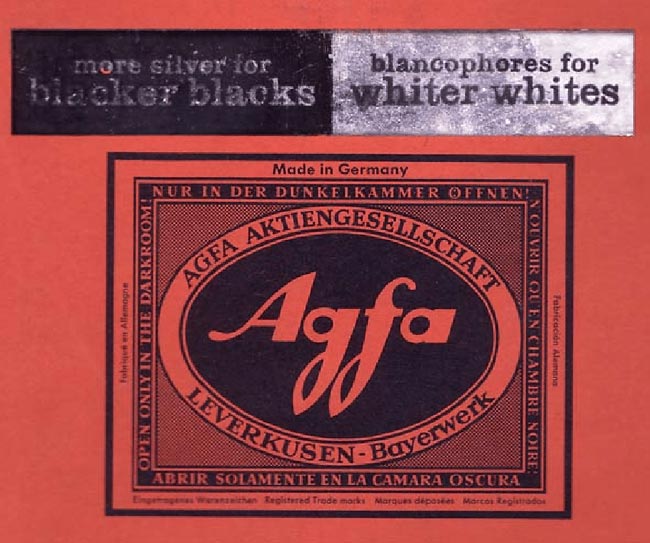
Toward the latter part of this date range the occurrence of optical brighteners rose with approximately 55% of all samples showing brighteners. Between 1970 and 1980, occurrence of optical brightening agents declined to approximately to 25% of all samples. A marked increase in occurrence was observed after 1980 when approximately 60% of samples exhibited optical brightening agents. These results indicate that a significant proportion, and for some time periods a significant majority, of fiber‐based silver gelatin prints made after the mid‐1950’s contain optical brightening agents. This finding has implications for the treatment and display of photographs as the presence of optical brightening agents is not routinely documented and the effects of storage environment, display and treatment are poorly understood. More recently, attention has shifted toward these issues with new findings on the visual impact and chemical stability of optical brighteners as well as considerations for treating optically brightened paper.
Key studies
- Survey of optically brightened photographic paper, Valerie Baas, Detroit Institute of Arts, Diane Tafilowski and Lauren Varga, 2003‐05
- Stability and visual impact of optical brighteners in photographic paper, Sandee Connors‐Rowe and Paul Whitmore, Art Conservation Research Center, Carnegie Mellon University, 2004‐06
- Impact of treatment on optically brightened photographs, Rachel Wetzel, Art Conservation Program, State University College at Buffalo, 2004‐05
- UV fluorescence survey: Standardizing imaging practices for the documentation of photographic paper fluorescence, Jiuan‐jiuan Chen, 2008 ‐
- Non‐UV simulation of fluorescence for optically brightened photographs, Hannah Morris & Paul Whitmore, Art Conservation Research Center, Carnegie Mellon University, 2011‐
4.2 Paper fiber
The presence of certain paper fibers unavailable prior to the mid‐1960s were key factors in exposing the fake Man Ray and Lewis Hine prints. Since that time the reference collection has been used to conduct a thorough and exacting survey of paper fibers and pulp processing techniques used by manufacturers of photographic paper in the 20th century. This work has been conducted in collaboration with the Museum of Modern Art and Integrated Paper Services of Appleton, Wisconsin, USA. For this survey reference samples dating from 1896 to 2006 were for used for fiber analysis.
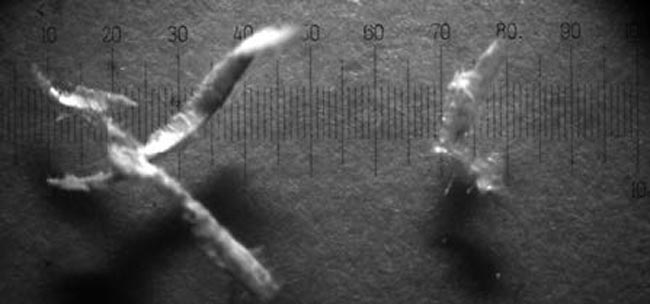
Principle analytical techniques involve the application of stains and the visual identification of fiber morphology to determine the fiber source and pulp processing methods. These data were compiled into a database and tested against results derived from photographic prints of known date. This method was found to be especially effective for dating paper made from circa 1900 to 1935 and after the mid 1960’s where levels of certainty can approach + / ‐ 5 to 7 years. Levels of certainty diminish toward the middle of the century as manufacturers were reliant on a fairly homogenous mix of fiber constituents during this period.
Key studies
- Lewis Hine authentication, Walter Rantanan, Integrated Paper Services, 1999
- Paper fiber identification and dating, Walter Rantanan, Integrated Paper Services, Lee Ann Daffner, Ana Martins, Museum of Modern Art, 2008‐
- Dating of photographic papers using nearIR, Ana Martins, Museum of Modern Art, 2010‐
4.3 Manufacturer markings
The photographic paper back‐printing project began in June 2007 and stemmed from an interest in documenting manufacturer‐applied markings while also providing a broad method for dating photographic prints with such markings. The results of this work are presented on the Paul Messier studio website. The markings on the site (http://paulmessier.com/backprinting/) are presented only for fiber‐based silver gelatin papers. Reflecting the strengths and weaknesses of the reference collection, most papers are North American and European in origin. Paper samples from manufacturer sample books and packages of unexposed paper were surveyed for backprinting. Of the over 3,000 samples assessed, only 278 examples of back‐printing were discovered (excluding special “postcard” papers, especially popular in the 1930’s and 1940’s).
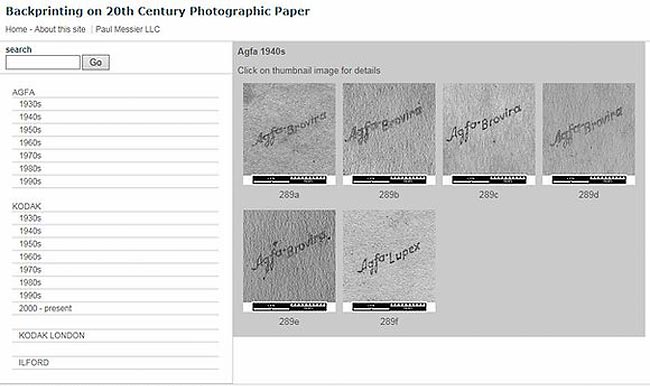
Once compiled, the papers were scanned, acquiring a detail, pattern and color images of each instance of back‐printing. The resulting scans then were organized on the website by manufacturer and date of production. To provide additional context, the scans on the site are accompanied by key cataloguing information as well images of the paper packaging or sample book cover. Most samples presented on the site are dated by the publication date of the book or the expiration date of the packaged paper. In some cases, especially for European paper, these dates are not present. In these instances samples are dated by qualitative factors including the image content of the sample books and logos and other design elements on packages of paper. The resulting date estimates presented on the site should be accurate within + / ‐ 5 years. Of note, the back‐printing survey confirmed the manufacturer Agfa used a two word back‐print design on paper made prior to circa 1957 and then shifted to a one word logo. Both the questioned Man Ray and Lewis Hine photographs showed the one‐word Agfa marking.
Key study
- Back‐printing survey, http://backprinting.com/, Christina Finlayson, 2007
4.4 Texture studies
4.4.1 Texture documentation, query and retrieval
The surface texture of a photographic print governs many of its key visual properties. Texture impacts tonal range, rendering of detail, reflectance and conveys subtle qualitative information about the discernment and aesthetic intent of a photographer. The result of a deliberate and competitive manufacturing process, textures applied to photographic paper also can provide valuable clues into the origin of prints of unknown or questioned provenance.
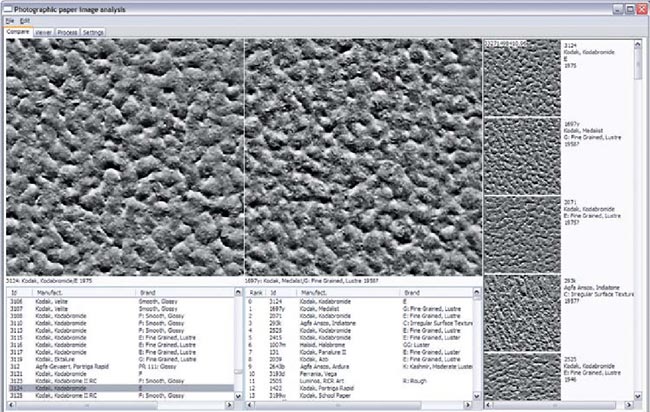
Photomicrographs of the surfaces of over 2,000 papers from the reference collection were gathered using a simple, but highly repeatable, system of lighting and digital image capture. Though a unique and valuable asset, this surface texture library alone has limited utility for the identification of unknown textures due to an inability to effectively query the collection and retrieve best matches. However, within the past few years three distinct signal processing methodologies have been developed by collaborators at the University of Indiana, the Eastman Kodak Company and Cornell University.
One method is based on rendering a Fourier transform from the texture images followed by the computation of a vector of average power per unit feature size. This procedure reduces each 2 MB gray scale image in the library to a list of 44 numbers that are easily stored, quickly recalled and compared. Developed independently, another technique relies on wavelet decomposition of the texture images coupled with metric learning techniques. Both methodologies show great promise for retrieving matches for unknowns from the library of texture images. A methodical evaluation of the techniques is ongoing and preliminary results are encouraging.
Assuming a positive outcome, the techniques used in these studies may have application for rapidly and inexpensively assembling and analyzing lookup and retrieval techniques for other textured materials such as textiles, painted surfaces and paper. In addition the large library of images at the base of this work can be used to develop and test new algorithms for querying large texture databases.
Key studies
- Fast Fourier transform (FFT) sorting, query and retrieval, Mark Messier, University of Indiana, 2008
- Wavelet feature extraction and machine learning, Charles Parker, Eastman Kodak Company, 2009
- System for texture lookup and retrieval, Harold Figueroa and Rick Johnson, Cornell University, 2011‐
- Micro‐RTI capture and texture characterization, Andrew Messier, 2010‐
4.4.2 A shared nomenclature for describing texture and gloss
The appearance of a silver gelatin print photograph is largely defined by surface texture and sheen. Manufacturers of 20th century photographic paper developed their own systems for describing these attributes, often consolidating them into proprietary surface designations. Manufacturer surface designations are interesting but ultimately these proprietary designations are of limited use when describing the full range and diversity of silver gelatin papers.
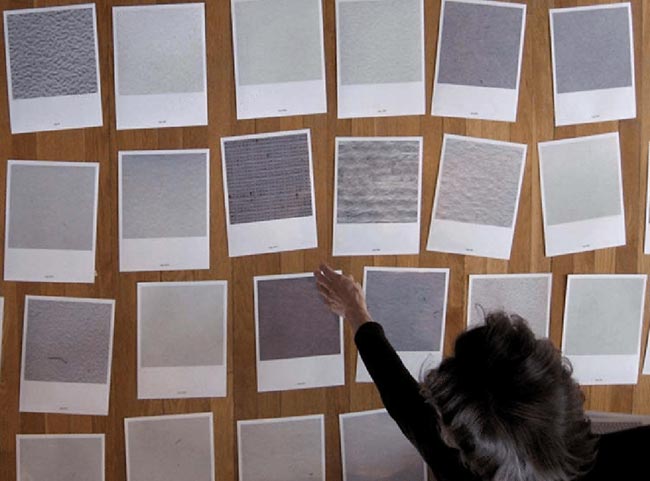
To create a shared vocabulary describing surfaces, classification experiments were conducted based on human observations. These subjective groupings identified by the sorting experiments were then assessed by direct measurement of gloss and surface texture. This work resulted in the formulation of six archetypal surface categories. Adoption and use of these proposed categories will help conservators, curators, collectors and other allied fields effectively communicate surface attributes when describing silver gelatin photographs.
Key studies
- Texture perception, James Coddington and Lee Ann Daffner, Museum of Modern Art, Khem Emrith and Mike Chantler, Texture Lab, Heriot‐Watt University, 2008‐
- Confocal microscopy‐based texture measurements correlated to reflectance, Kevin Vessot and Christopher Brown, Worcester Polytechnic University, 2009‐10
4.5 Elemental composition
Papers from the reference collection, all identified by manufacturer, brand, date and finish were used as the basis for research coordinated by Dusan Stulik, Senior Scientist, Getty Conservation Institute. A primary focus of this research was a survey of elements detected using x‐ray fluorescence spectroscopy (XRF). Among the common elements detected were barium and strontium (from the baryta layer), calcium (paper base) and often chromium (present as a gelatin hardening agent). Quantitative measurement of these elements, especially when compared to a baseline of papers of known provenance, provides clues into the origins of prints helping identify manufacturer and date. Other analytical techniques used to survey the papers included inductively coupled plasma‐mass spectrometry (ICP‐MS) and neutron activation analysis (NAA). These techniques were used to confirm and extend the quantitative XRF analysis as well as to search for additional trace elements that could be useful in provenance studies. The distribution of key elements identified by the survey, as well as trace elements such as aluminum, silicon, potassium, manganese, iron, copper potassium and chromium, within the multiple layers of a gelatin silver photograph was documented. Cross sections of photographic paper were used to render elemental “maps” showing the location and relative concentrations of these and other elements using electron microprobe analyzer (EMPA) as well as a combination of dispersive Xray analyzer (EDX) and ICP‐MS. Accurate calculation of elemental concentrations is reliant on the measurement of certain physical parameters of silver gelatin paper. Therefore the GCI‐based research including measurements of baryta particle size, overall paper thickness, emulsion thickness, emulsion super coat thickness, baryta thickness and paper density.
Since the major research program at the Getty, additional and ongoing work involves isolating specific inorganic elements that are uniquely associated with pigments, coatings and paper sizing and wet strength agents. Work at the Museum of Modern Art has focused on the concentrations of barium, strontium, aluminum, silicon, sulfur, potassium, titanium and iron. The changes in the abundance of these elements over the 20th century not only provide insight into the date of the photographic print but also how it was manufactured and any particular preservation related vulnerabilities including the identification of paper stock prepared with potentially destructive alum‐rosin sizing.
Specific to dating, a systematic survey of reference collection is underway to document the radiocarbon content of photographic paper. Levels of 14C, the radioactive isotope of carbon, in organic material show marked increase in the years following the Second World War and peak in the mid‐1960s as a result of above‐ground nuclear weapons testing. Radiocarbon levels decrease throughout the 1970’s though concentrations of 14C today remain roughly 13% above levels measured prior to the early 1950’s. By plotting the concentration of this “bomb carbon” over time, radiocarbon dating holds the promise of dating a photographic print pre‐ or post‐circa 1950. If the paper was made post‐1950, and therefore contains elevated levels of 14C, there is a potential of providing a paper manufacture date with an accuracy of +/‐ 3 to 5 years.
Key studies
- Quantitative XRF studies, Dusan Stulik & Art Kaplan, Getty Conservation Institute, 2005‐06
- Trace metal composition, David Miller, California State University, Northridge, 2005‐06
- Semi‐quantitative XRF studies, Ana Martins, Chris McGlinchey and Alisha Chipman, Museum of Modern Art, 2008‐09
- Atomic Bomb‐Derived Radiocarbon Content, Greg Hodgins & Dana Drake Rosenstein, University of Arizona, 2011‐
5. Vision, goals and next steps
The success and limitations of this work illustrate the value and necessity of employing characterization methods to reference collections of known origin. Likewise, the application of these techniques is gradually being focused on the documentation of materials‐based characteristics of prints from individual master photographers, including Lewis Hine, Man Ray and Henri Cartier‐ Bresson. Aggregated in databases, such knowledge will clarify crucial questions about authenticity and provenance, and provide tremendous insight into how a particular print represents the artistic intent of a photographer.
As this sort of research becomes more conventional within collecting institutions, an important benefit will be the ability to disseminate results through publications, conferences, and discussions within all ranks of the collecting community. Going forward, the impact of this dialogue should garner the support required for more comprehensive and more evolved research programs. For example, with a solid grounding in materials, the catalogue raisonné, so critical for scholarship in other artistic media, can be meaningfully retooled for the medium of photography.
New generations of analytical methods are in rapid development, especially for spectral analysis and imaging. Applied to reference collections of photographic papers, these tools can be used to build widely accessible databases of key chemical and physical markers. Resulting baseline data then can be analyzed using statistical, signal processing and machine learning techniques. These analytical techniques combined with computer science methodologies can be applied to insure that future art historical discernment is grounded in objective, empirical fact about print origin and makeup.
Applications yielding insights into artistic practice, authenticity and preservation requirements can be developed and employed for collecting institutions, individual collectors and the art market. Along with the assembly, cataloging and analysis of reference collections, significant effort is required to record the working practices of individual photographers. Over time, these artist‐based collections will increase in scholarly value and could form the basis for the production of catalogue raisonnés and for authentication studies.
Despite great future potential, there is nothing novel about assembling and analyzing research collections of artist material. Work performed on the Forbes Collection of pigments and resins conducted at Harvard’s Fogg Museum, starting in the late 1920’s, not only established the value of reference collections but, in many respects, founded the contemporary field of art conservation in America. Beyond the Fogg, several museum conservation departments, including those at the Getty Conservation Institute and the National Gallery of Art, have assembled reference collections of paints, papers and varnishes. These collections serve the research agendas of conservators, curators and related scholars. However, none of these collections is focused on photographic materials. Building on the precedent established at the Fogg and elsewhere, a new commitment is required to form a center dedicated to researching the materials of the photographer.
Ideally, the Center would be located within a museum of modern and contemporary art and would augment a well‐established conservation department. The Center could also exist as a collaborative project between two or more such institutions. A multi‐disciplinary staff led by an analytical scientist, a computer scientist and an art conservator would be required. A staff cataloguer would describe and manage the reference collections, making them accessible to researchers. Research conducted at the Center would be based on collaborations with scientists, conservators and art historians working in academia, industry, museums and private practice. The Center would provide an ideal environment for conducting graduate and postgraduate research in various fields, including computer science, imaging, statistics, analytical chemistry, art history and art conservation. By providing reference collections and making available basic analytical equipment, the staff and associates of the Center would significantly augment the capacities of the host institutions to assess, preserve and interpret their permanent collections.
The establishment of such a Center is well‐timed. For materials of every description, a “new age” of classification has begun. New generation classification systems are being built around increasingly powerful and less expensive analytical tools for assessing chemical and physical properties. Resulting data sets are mined with ever‐increasing capacity to identify and assign meaning to underlying patterns using emerging computer science and statistical protocols.
A photograph is a complex combination of aesthetic and intellectual content. In addition, every photographic print is an expression of material culture. Materials provide the link to the moment of artistic creation and govern the present‐day experience. Materials, enormously diverse, complex and sophisticated, play a vital role in the interpretation and preservation of artistic intent. As demonstrated by the past and ongoing research outlined above, understanding photographic materials is a challenge that can only be met through a lasting program of systematic and methodical classification.
Paul Messier is a conservator of photographs and the founder and Pritzker Director of the Lens Media Lab at Yale University’s Institute for the Preservation of Cultural Heritage.

